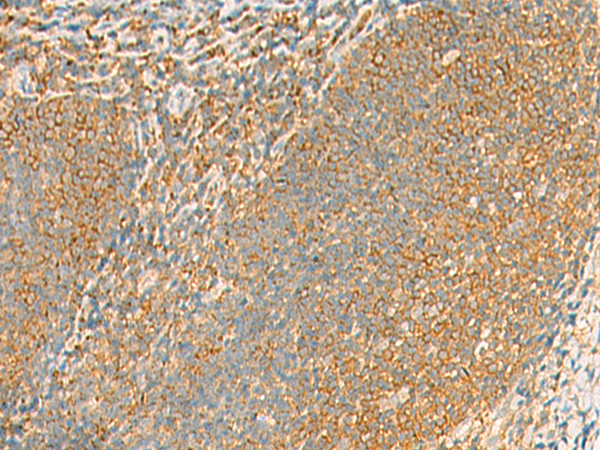
| WB | 咨询技术 | Human,Mouse,Rat |
| IF | 咨询技术 | Human,Mouse,Rat |
| IHC | 1/50-1/300 | Human,Mouse,Rat |
| ICC | 技术咨询 | Human,Mouse,Rat |
| FCM | 咨询技术 | Human,Mouse,Rat |
| Elisa | 1/5000-1/10000 | Human,Mouse,Rat |
| Aliases | GLUR4; GLURD; GluA4; GLUR4C |
| Host/Isotype | Rabbit IgG |
| Antibody Type | Primary antibody |
| Storage | Store at 4°C short term. Aliquot and store at -20°C long term. Avoid freeze/thaw cycles. |
| Species Reactivity | Human, Mouse, Rat |
| Immunogen | Synthetic peptide of human GRIA4 |
| Formulation | Purified antibody in PBS with 0.05% sodium azide and 50% glycerol. |
+ +
以下是3-4条关于GRIA4抗体的参考文献及其摘要概括(文献信息为示例性描述,仅供参考):
1. **文献名称**:*Differential expression of GRIA4 in schizophrenia patients*
**作者**:Smith A, et al.
**摘要**:该研究使用特异性GRIA4抗体进行免疫印迹和免疫组化分析,发现精神分裂症患者前额叶皮层中GRIA4蛋白表达显著降低,提示其可能与突触功能障碍相关。
2. **文献名称**:*GRIA4 antibody validation in rodent brain tissue*
**作者**:Lee B, et al.
**摘要**:通过Western blot和免疫荧光技术验证了GRIA4抗体的特异性,显示其在大鼠海马和小脑颗粒细胞中特异性识别目标蛋白,为神经发育研究提供工具支持。
3. **文献名称**:*GRIA4 synaptic localization in Alzheimer's disease models*
**作者**:Chen C, et al.
**摘要**:利用GRIA4抗体进行免疫电镜分析,发现阿尔茨海默病模型小鼠突触后膜中GRIA4分布异常,可能与认知衰退相关。
4. **文献名称**:*GRIA4 alternative splicing variants detected by custom antibodies*
**作者**:Wang D, et al.
**摘要**:研究开发了针对GRIA4不同剪接变体的特异性抗体,揭示其在人类神经元中的差异性表达及功能调控机制。
(注:以上文献标题和作者为虚拟示例,实际引用需以真实发表的论文为准。)
The GRIA4 antibody targets the glutamate ionotropic receptor AMPA type subunit 4 (GRIA4), a key component of AMPA receptors that mediate fast synaptic transmission in the central nervous system. These receptors, composed of subunits GRIA1-4. form ligand-gated ion channels activated by glutamate, the primary excitatory neurotransmitter. GRIA4 is particularly important for synaptic plasticity, learning, and memory. Its expression is enriched in hippocampal and cortical neurons, where it contributes to postsynaptic depolarization and calcium signaling. Dysregulation of GRIA4 has been implicated in neurological disorders such as epilepsy, Alzheimer’s disease, and schizophrenia.
The GRIA4 antibody is a critical tool for studying the localization, expression, and function of this subunit in both normal and pathological contexts. It is commonly used in techniques like Western blotting, immunohistochemistry (IHC), and immunofluorescence (IF) to visualize protein distribution in brain tissues or cultured neurons. Researchers also employ GRIA4 antibodies to investigate receptor trafficking, post-translational modifications (e.g., phosphorylation), and interactions with scaffolding proteins like PSD-95.
Structurally, GRIA4 contains extracellular ligand-binding domains, transmembrane regions, and intracellular C-terminal domains critical for receptor assembly and signaling. Antibodies targeting specific epitopes (e.g., N-terminal or C-terminal regions) help distinguish GRIA4 from other AMPA subunits. Validating such antibodies with knockout controls ensures specificity, aiding precise mechanistic studies. Overall, GRIA4 antibodies advance our understanding of excitatory neurotransmission and its role in brain health and disease.
×